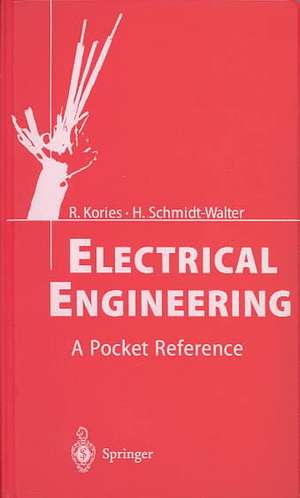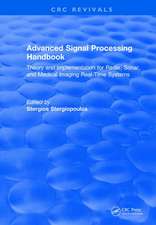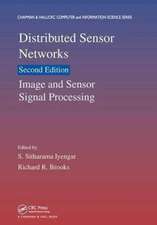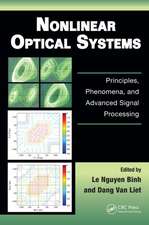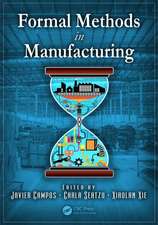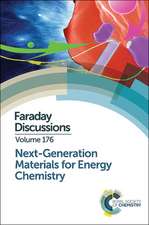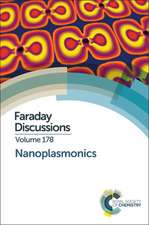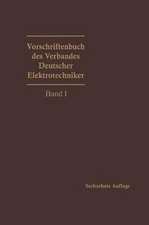Electrical Engineering: A Pocket Reference
Autor Ralf Kories, Heinz Schmidt-Walteren Limba Engleză Paperback – 9 iul 2003
Preț: 983.58 lei
Preț vechi: 1199.48 lei
-18% Nou
Puncte Express: 1475
Preț estimativ în valută:
188.23€ • 195.40$ • 156.95£
188.23€ • 195.40$ • 156.95£
Carte tipărită la comandă
Livrare economică 22 martie-05 aprilie
Preluare comenzi: 021 569.72.76
Specificații
ISBN-13: 9783540439653
ISBN-10: 354043965X
Pagini: 648
Ilustrații: XXII, 626 p. 10 illus.
Dimensiuni: 129 x 198 x 34 mm
Greutate: 1.54 kg
Ediția:Softcover reprint of the original 1st ed. 2003
Editura: Springer Berlin, Heidelberg
Colecția Springer
Locul publicării:Berlin, Heidelberg, Germany
ISBN-10: 354043965X
Pagini: 648
Ilustrații: XXII, 626 p. 10 illus.
Dimensiuni: 129 x 198 x 34 mm
Greutate: 1.54 kg
Ediția:Softcover reprint of the original 1st ed. 2003
Editura: Springer Berlin, Heidelberg
Colecția Springer
Locul publicării:Berlin, Heidelberg, Germany
Public țintă
Professional/practitionerCuprins
1 DC Systems.- 1.1 Basic Quantities, Basic Laws.- 1.1.1 Electric Charge.- 1.1.2 Electric Current.- 1.1.3 Voltage and Potential.- 1.1.4 Ohm’s Law.- 1.1.5 Resistance and Conductance.- 1.1.6 Temperature Dependence of Resistance.- 1.1.7 Inductance.- 1.1.8 Capacitance.- 1.1.9 Ideal Voltage Source.- 1.1.10 Ideal Current Source.- 1.1.11 Kirchhoff’s Law.- 1.1.11.1 Kirchhoff’s First Law (Current Law).- 1.1.11.2 Kirchhoff’s Second Law (Voltage Law).- 1.1.12 Power and Energy.- 1.1.12.1 Energy and Power in a Resistor.- 1.1.12.2 Energy in an Inductor.- 1.1.12.3 Energy in a Capacitor.- 1.1.13 Efficiency.- 1.1.14 Maximum Power Transfer.- 1.2 Basic Circuits.- 1.2.1 Real Voltage and Current Sources.- 1.2.1.1 Real Voltage Source.- 1.2.1.2 Real Current Source.- 1.2.1.3 Voltage-Current Source Conversion.- 1.2.2 Circuit Elements in Series and Parallel.- 1.2.2.1 Series Combination of Resistors.- 1.2.2.2 Parallel Combination of Resistors.- 1.2.2.3 Series Combination of Conductances.- 1.2.2.4 Parallel Combination of Conductances.- 1.2.2.5 Series Combination of Inductances.- 1.2.2.6 Parallel Combination of Inductances.- 1.2.2.7 Series Combination of Capacitances.- 1.2.2.8 Parallel Combination of Capacitances.- 1.2.3 Star-Delta Transformation.- 1.2.4 Voltage and Current Divider.- 1.2.4.1 Voltage Divider.- 1.2.4.2 Current Divider.- 1.2.4.3 Capacitive and Inductive Dividers.- 1.2.5 RC and RL Combinations.- 1.2.5.1 Series Combination of R and C Driven by a Voltage Source.- 1.2.5.2 Series Combination of R and C Driven by a Current Source.- 1.2.5.3 Parallel Combination of R and C Driven by a Current Source.- 1.2.5.4 Parallel Combination of R and C Driven by a Voltage Source.- 1.2.5.5 Series Combination of R and L Driven by a Voltage Source.- 1.2.5.6 Series Combination of R and L Driven by a Current Source.- 1.2.5.7 Parallel Combination of R and L Driven by a Voltage Source.- 1.2.5.8 Parallel Combination of R and L Driven by a Current Source.- 1.2.6 RLC Combinations.- 1.2.6.1 Series Combination of R, L and C.- 1.3 Calculation Methods for Linear Circuits.- 1.3.1 Rules for Signs.- 1.3.2 Circuit Calculation with Mesh and Node Analysis.- 1.3.3 Superposition.- 1.3.4 Mesh Analysis.- 1.3.5 Node Analysis.- 1.3.6 Thévenin’s and Norton’s Theorem.- 1.3.6.1 Calculating a Load Current by Thévenin’s Theorem.- 1.3.6.2 Calculating a Current Within a Network.- 1.4 Notation Index.- 1.5 Further Reading.- 2 Electric Fields.- 2.1 Electrostatic Fields.- 2.1.1 Coulomb’s Law.- 2.1.2 Definition of Electric Field Strength.- 2.1.3 Voltage and Potential.- 2.1.4 Electrostatic Induction.- 2.1.5 Electric Displacement.- 2.1.6 Dielectrics.- 2.1.7 The Coulomb Integral.- 2.1.8 Gauss’s Law of Electrostatics.- 2.1.9 Capacitance.- 2.1.10 Electrostatic Field at a Boundary.- 2.1.11 Overview: Fields and Capacitances of Different Geometric Configurations.- 2.1.12 Energy in an Electrostatic Field.- 2.1.13 Forces in an Electrostatic Field.- 2.1.13.1 Force on a Charge.- 2.1.13.2 Force at the Boundary.- 2.1.14 Overview: Characteristics of an Electrostatic Field.- 2.1.15 Relationship between the Electrostatic Field Quantities.- 2.2 Static Steady-State Current Flow.- 2.2.1 Voltage and Potential.- 2.2.2 Current.- 2.2.3 Electric Field Strength.- 2.2.4 Current Density.- 2.2.5 Resistivity and Conductivity.- 2.2.6 Resistance and Conductance.- 2.2.7 Kirchhoff’s Laws.- 2.2.7.1 Kirchhoff’s First Law (Current Law).- 2.2.7.2 Kirchhoff’s Second Law (Mesh Law).- 2.2.8 Static Steady-State Current Flow at Boundaries.- 2.2.9 Overview: Fields and Resistances of Different Geometric Configurations.- 2.2.10 Power and Energy in Static Steady-State Current Flow.- 2.2.11 Overview: Characteristics of Static Steady-State Current Flow.- 2.2.12 Relationship Between Quantities in Static Steady-StateCurrent Flow.- 2.3 Magnetic Fields.- 2.3.1 Force on a Moving Charge.- 2.3.2 Definition of Magnetic Flux Density.- 2.3.3 Biot-Savart’s Law.- 2.3.4 Magnetic Field Strength.- 2.3.5 Magnetic Flux.- 2.3.6 Magnetic Voltage and Ampere’s Law.- 2.3.7 Magnetic Resistance, Magnetic Conductance, Inductance.- 2.3.8 Materials in a Magnetic Field.- 2.3.8.1 Ferromagnetic Materials.- 2.3.9 Magnetic Fields at Boundaries.- 2.3.10 The Magnetic Circuit.- 2.3.11 Magnetic Circuit with a Permanent Magnet.- 2.3.12 Overview: Inductances of Different Geometric Configurations.- 2.3.13 Induction.- 2.3.13.1 Induction in a Moving Electrical Conductor.- 2.3.13.2 Faraday’s Law of Induction.- 2.3.13.3 Self-Induction.- 2.3.14 Mutual Induction.- 2.3.15 Transformer Principle.- 2.3.16 Energy in a Magnetic Field.- 2.3.16.1 Energy in a Magnetic Circuit with an Air Gap.- 2.3.17 Forces in a Magnetic Field.- 2.3.17.1 Force on a Current-Carrying Conductor.- 2.3.17.2 Force at the Boundaries.- 2.3.18 Overview: Characteristics of a Magnetic Field.- 2.3.19 Relationship between the Magnetic Field Quantities.- 2.4 Maxwell’s Equations.- 2.5 Notation Index.- 2.6 Further Reading.- 3 AC Systems.- 3.1 Mathematical Basics of AC.- 3.1.1 Sine and Cosine Functions.- 3.1.1.1 Addition of SinusoidalWaveforms.- 3.1.2 Complex Numbers.- 3.1.2.1 Complex Arithmetic.- 3.1.2.2 Representation of Complex Numbers.- 3.1.2.3 Changing Between Different Representations.- 3.1.3 Complex Calculus.- 3.1.3.1 Complex Addition and Subtraction.- 3.1.3.2 Multiplication of Complex Numbers.- 3.1.4 Overview: Complex Number Arithmetic.- 3.1.5 The Complex Exponential Function.- 3.1.5.1 Exponential Function with Imaginary Exponents.- 3.1.5.2 Exponential Function with Complex Exponents.- 3.1.6 Trigonometric Functions with Complex Arguments.- 3.1.7 From Sinusoidal Waveforms to Phasors.- 3.1.7.1 Complex Magnitude.- 3.1.7.2 Relationship Between SinusoidalWaveforms and Phasors.- 3.1.7.3 Addition and Subtraction of Phasors.- 3.2 Sinusoidal Waveforms.- 3.2.1 Characteristics of SinusoidalWaveforms.- 3.2.2 Characteristics of Nonsinusoidal Waveforms.- 3.3 Complex Impedance and Admittance.- 3.3.1 Impedance.- 3.3.2 Complex Impedance of Passive Components.- 3.3.2.1 Resistor.- 3.3.2.2 Inductor.- 3.3.2.3 Capacitor.- 3.3.3 Admittance.- 3.3.4 Complex Admittance of Passive Components.- 3.3.5 Overview: Complex Impedance.- 3.4 Impedance of Passive Components.- 3.5 Combinations of Passive Components.- 3.5.1 Series Combinations.- 3.5.1.1 General Case.- 3.5.1.2 Resistor and Inductor in Series.- 3.5.1.3 Resistor and Capacitor in Series.- 3.5.1.4 Resistor, Inductor and Capacitor in Series.- 3.5.2 Parallel Combinations.- 3.5.2.1 General Case.- 3.5.2.2 Resistor and Inductor in Parallel.- 3.5.2.3 Resistor and Capacitor in Parallel.- 3.5.2.4 Resistor, Inductor and Capacitor in Parallel.- 3.5.3 Overview of Series and Parallel Circuits.- 3.6 Network Transformations.- 3.6.1 Transformation from Parallel to Series Circuits and Vice Versa.- 3.6.2 Sta-Delta (Wye-Delta) and Delta-Star (Delta-Wye) Transformations.- 3.6.3 Circuit Duality.- 3.7 Simple Networks.- 3.7.1 Complex Voltage and Current Division.- 3.7.2 Loaded Complex Voltage Divider.- 3.7.3 Impedance Matching.- 3.7.4 Voltage Divider with Defined Input and Output Resistances.- 3.7.5 Phase-Shifting Circuits.- 3.7.5.1 RC Phase Shifter.- 3.7.5.2 Alternative Phase-Shifting Circuits.- 3.7.6 AC Bridges.- 3.7.6.1 Balancing Condition.- 3.7.6.2 Application: Measurement Technique.- 3.8 Power in AC Circuits.- 3.8.1 Instantaneous Power.- 3.8.1.1 Power in a Resistance.- 3.8.1.2 Power in a Reactive Element.- 3.8.2 Average Power.- 3.8.2.1 Real Power.- 3.8.2.2 Reactive Power.- 3.8.2.3 Apparent Power.- 3.8.3 Complex Power.- 3.8.4 Overview: AC Power.- 3.8.5 Reactive Current Compensation.- 3.9 Three-Phase Supplies.- 3.9.1 Polyphase Systems.- 3.9.2 Three-Phase Systems.- 3.9.2.1 Properties of the Complex Operator a.- 3.9.3 Delta-Connected Generators.- 3.9.4 Star-Connected Generators.- 3.10 Overview: Symmetrical Three-Phase Systems.- 3.10.1 Power in a Three-Phase System.- 3.11 Notation Index.- 3.12 Further Reading.- 4 Current, Voltage and Power Measurement.- 4.1 Electrical Measuring Instruments.- 4.1.1 Moving-Coil Instrument.- 4.1.2 Ratiometer Moving-Coil Instrument.- 4.1.3 Electrodynamic Instrument.- 4.1.4 Moving-Iron Instrument.- 4.1.5 Other Instruments.- 4.1.6 Overview: Electrical Instruments.- 4.2 Measurement of DC Current and Voltage.- 4.2.1 Moving-Coil Instrument.- 4.2.2 Range Extension for Current Measurements.- 4.2.3 Range Extension for Voltage Measurements.- 4.2.4 Overload Protection.- 4.2.5 Systematic Measurement Errors in Current and Voltage Measurement.- 4.3 Measurement of AC Voltage and AC Current.- 4.3.1 Moving-Coil Instrument with Rectifier.- 4.3.2 Moving-Iron Instruments.- 4.3.3 Measurement Range Extension Using an Instrument Transformer.- 4.3.4 RMS Measurement.- 4.4 Power Measurement.- 4.4.1 Power Measurement in a DC Circuit.- 4.4.2 Power Measurement in an AC Circuit.- 4.4.2.1 Three-Voltmeter Method.- 4.4.2.2 Power Factor Measurement.- 4.4.3 Power Measurement in a Multiphase System.- 4.4.3.1 Measurement of the Real Power in a Multiphase System.- 4.4.3.2 Measurement of the Reactive Power in a Multiphase System.- 4.5 Measurement Errors.- 4.5.1 Systematic and Random Errors.- 4.5.2 Guaranteed Error Limits.- 4.6 Overview: Symbols on Measurement Instruments.- 4.7 Overview: Measurement Methods.- 4.8 Notation Index.- 4.9 Further Reading.- 5 Networks at Variable Frequency.- 5.1 Linear Systems.- 5.1.1 Transfer Function, Amplitude and Phase Response.- 5.2 Filters.- 5.2.1 Low-Pass Filter.- 5.2.2 High-Pass Filter.- 5.2.3 Bandpass Filter.- 5.2.4 Stop-Band Filter.- 5.2.5 All-Pass Filter.- 5.3 Simple Filters.- 5.3.1 Low-Pass Filter.- 5.3.1.1 Rise Time.- 5.3.2 Frequency Normalisation.- 5.3.2.1 Approximation of the Magnitude Response.- 5.3.3 High-Pass Filter.- 5.3.3.1 Approximation of the Magnitude Response.- 5.3.4 Higher-Order Filters.- 5.3.5 Bandpass Filter.- 5.3.6 Filter Realisation.- 5.4 Notation Index.- 5.5 Further Reading.- 6 Signals and Systems.- 6.1 Signals.- 6.1.1 Definitions.- 6.1.2 Symmetry Properties of Signals.- 6.2 Fourier Series.- 6.2.1 Trigonometric Form.- 6.2.1.1 Symmetry Properties.- 6.2.2 Amplitude-Phase Form.- 6.2.3 Exponential Form.- 6.2.3.1 Symmetry Properties.- 6.2.4 Overview: Fourier Series Representations.- 6.2.5 Useful Integrals for the Calculation of Fourier Coefficients.- 6.2.6 Useful Fourier Series.- 6.2.7 Application of the Fourier Series.- 6.2.7.1 Spectrum of a Rectangular Signal.- 6.2.7.2 Spectrum of a Sawtooth Signal.- 6.2.7.3 Spectrum of a Composite Signal.- 6.3 Systems.- 6.3.1 System Properties.- 6.3.1.1 Linear Systems.- 6.3.1.2 Causal Systems.- 6.3.1.3 Time-Invariant Systems.- 6.3.1.4 Stable Systems.- 6.3.1.5 LTI Systems.- 6.3.2 Elementary Signals.- 6.3.2.1 The Step Function.- 6.3.2.2 The Rectangular Pulse.- 6.3.2.3 The Triangular Pulse.- 6.3.2.4 The Gaussian Pulse.- 6.3.2.5 The Impulse Function (Delta Function).- 6.3.3 Shifting and Scaling of Time Signals.- 6.3.4 System Responses.- 6.3.4.1 Impulse Response.- 6.3.4.2 Step Response.- 6.3.4.3 System Response to Arbitrary Input Signals.- 6.3.4.4 Rules of Convolution.- 6.3.4.5 Transfer Function.- 6.3.4.6 System Response Calculation in the Frequency Domain.- 6.3.5 Impulse and Step Response Calculation.- 6.3.5.1 Normalisation of Circuits.- 6.3.5.2 Impulse and Step Response of First-Order Systems.- 6.3.5.3 Impulse and Step Response of Second-Order Systems.- 6.3.6 Ideal Systems.- 6.3.6.1 Distortion-Free Systems.- 6.3.6.2 Ideal Low-Pass Filter.- 6.3.6.3 Ideal Bandpass Filter.- 6.4 Fourier Transforms.- 6.4.1 Principle.- 6.4.2 Definition.- 6.4.3 Representation of the Fourier Transform.- 6.4.3.1 Symmetry Properties.- 6.4.4 Overview: Properties of the Fourier Transform.- 6.4.5 Fourier Transforms of Elementary Signals.- 6.4.5.1 Spectrum of the Delta Function.- 6.4.5.2 Spectrum of the Signum and the Step Functions.- 6.4.5.3 Spectrum of the Rectangular Pulse.- 6.4.5.4 Spectrum of the Triangular Pulse.- 6.4.5.5 Spectrum of the Gaussian Pulse.- 6.4.5.6 Spectrum of Harmonic Functions.- 6.4.6 Summary of Fourier Transforms.- 6.5 Nonlinear Systems.- 6.5.1 Definition.- 6.5.2 Characterisation of Nonlinear Systems.- 6.5.2.1 Characteristic Equation.- 6.5.2.2 Total Harmonic Distortion.- 6.5.2.3 Signal-to-Intermodulation Ratio.- 6.6 Notation Index.- 6.7 Further Reading.- 7 Analogue Circuit Design.- 7.1 Methods of Analysis.- 7.1.1 Linearisation at the Operating Point.- 7.1.2 AC Equivalent Circuit.- 7.1.3 Input and Output Impedance.- 7.1.3.1 Determination of the Input Impedance.- 7.1.3.2 Determination of the Output Impedance.- 7.1.3.3 Combination of Two-Terminal Networks.- 7.1.4 Two-Port Networks.- 7.1.4.1 Two-Port Network Equations.- 7.1.4.2 Hybrid Parameters (h-Parameters).- 7.1.4.3 Admittance Parameters (y-Parameters).- 7.1.5 Block Diagrams.- 7.1.5.1 Calculation Rules for Block Diagrams.- 7.1.6 Bode Plot.- 7.2 Silicon and Germanium Diodes.- 7.2.1 Current-Voltage Characteristic of Si and Ge Diodes.- 7.2.2 Temperature Dependency of the Threshold Voltage.- 7.2.3 Dynamic Resistance (Differential Resistance).- 7.3 Small-Signal Amplifier with Bipolar Transistors.- 7.3.1 Transistor Characteristics.- 7.3.1.1 Symbols, Voltages and Currents for Bipolar Transistors.- 7.3.1.2 Output Characteristics.- 7.3.1.3 Transfer Characteristic.- 7.3.1.4 Input Characteristic.- 7.3.1.5 Static Current Gain ?DC.- 7.3.1.6 Differential Current Gain ?.- 7.3.1.7 Transconductance gm.- 7.3.1.8 Thermal Voltage Drift.- 7.3.1.9 Differential Input Resistance rBE.- 7.3.1.10 Differential Output Resistance rinCE.- 7.3.1.11 Reverse Voltage-Transfer Ratio Ar.- 7.3.1.12 Unity Gain and Critical Frequencies.- 7.3.2 Equivalent Circuits.- 7.3.2.1 Static Equivalent Circuit.- 7.3.2.2 AC Equivalent Circuit.- 7.3.2.3 The Giacoletto Equivalent Circuit.- 7.3.3 Darlington Pair.- 7.3.3.1 Pseudo-Darlington Pair.- 7.3.4 Basic Circuits with Bipolar Transistors.- 7.3.5 Common-Emitter Circuit.- 7.3.5.1 Common-Emitter Circuit Two-Port Network Equations.- 7.3.5.2 Common-Emitter AC Equivalent Circuit.- 7.3.5.3 Common-Emitter Circuit Input Impedance.- 7.3.5.4 Common-Emitter Circuit Output Impedance.- 7.3.5.5 Common-Emitter Circuit AC Voltage Gain.- 7.3.5.6 Operating Point Biasing.- 7.3.5.7 Operating Point Stabilisation.- 7.3.5.8 Load Line.- 7.3.5.9 Common-Emitter Circuit at High Frequencies.- 7.3.6 Common-Collector Circuit (Emitter Follower).- 7.3.6.1 Common-Collector AC Equivalent Circuit.- 7.3.6.2 Common-Collector Circuit Input Impedance.- 7.3.6.3 Common-Collector Circuit Output Impedance.- 7.3.6.4 Common-Collector Circuit AC Current Gain.- 7.3.6.5 Common-Collector Circuit at High Frequencies.- 7.3.7 Common-Base Circuit.- 7.3.7.1 Common-Base AC Equivalent Circuit.- 7.3.7.2 Common-Base Circuit Input Impedance.- 7.3.7.3 Common-Base Circuit Output Impedance.- 7.3.7.4 Common-Base Circuit AC Voltage Gain.- 7.3.7.5 Common-Base Circuit at High Frequencies.- 7.3.8 Overview: Basic Bipolar Transistor Circuits.- 7.3.9 Bipolar Transistor Current Sources.- 7.3.10 Bipolar Transistor Differential Amplifier.- 7.3.10.1 Differential Mode Gain.- 7.3.10.2 Common-Mode Gain.- 7.3.10.3 Common-Mode Rejection Ratio.- 7.3.10.4 Differential Amplifier Input Impedance.- 7.3.10.5 Differential Amplifier Output Impedance.- 7.3.10.6 Offset Voltage of the Differential Amplifier.- 7.3.10.7 Differential Amplifier Offset Current.- 7.3.10.8 Input Offset Voltage Drift.- 7.3.10.9 Differential Amplifier Examples.- 7.3.11 Overview: Bipolar Transistor Differential Amplifiers.- 7.3.12 Current Mirror.- 7.3.12.1 Current Mirror Variations.- 7.4 Field-Effect Transistor Small-Signal Amplifiers.- 7.4.1 Transistor Characteristics and Ratings.- 7.4.1.1 Symbols, Voltages and Currents for Field-Effect Transistors.- 7.4.1.2 JFET Characteristic Curves.- 7.4.1.3 IGFET Characteristic Curves.- 7.4.1.4 Transconductance.- 7.4.1.5 Dynamic Output Resistance.- 7.4.1.6 Input Impedance.- 7.4.2 Equivalent Circuit.- 7.4.2.1 Equivalent Circuit for Low Frequencies.- 7.4.2.2 Equivalent Circuit for High Frequencies.- 7.4.2.3 Critical Frequency of Transconductance.- 7.4.3 Basic Circuits using Field-Effect Transistors.- 7.4.4 Common-Source Circuit.- 7.4.4.1 Common-Source Two-Port Parameters.- 7.4.4.2 AC Equivalent Circuit of the Common-Source Circuit.- 7.4.4.3 Input Impedance of the Common-Source Circuit.- 7.4.4.4 Output Impedance of the Common-Source Circuit.- 7.4.4.5 AC Voltage Gain.- 7.4.4.6 Operating-Point Biasing.- 7.4.4.7 Common-Drain Circuit, Source Follower.- 7.4.4.8 AC Equivalent Circuit of the common-drain Circuit.- 7.4.4.9 Input Impedance of the Common-Drain Circuit.- 7.4.4.10 Output Impedance of the Common-Drain Circuit.- 7.4.4.11 Voltage Gain of the Common-Drain Circuit.- 7.4.4.12 Common-Drain Circuit at High Frequencies.- 7.4.5 Common-Gate Circuit.- 7.4.5.1 Input Impedance of the Common-Gate Circuit.- 7.4.5.2 Output Impedance of the Common-Gate Circuit.- 7.4.5.3 Voltage Gain of the Common-Gate Circuit.- 7.4.6 Overview: Basic Circuits using Field-Effect Transistors.- 7.4.7 FET Current Source.- 7.4.8 Differential Amplifier with Field-Effect Transistors.- 7.4.8.1 Differential Mode Gain.- 7.4.8.2 Common-Mode Gain.- 7.4.8.3 Common-Mode Rejection Ratio.- 7.4.8.4 Input Impedance.- 7.4.8.5 Output Impedance.- 7.4.9 Overview: Differential Amplifier with FETs.- 7.4.10 Controllable Resistor FETs.- 7.5 Negative Feedback.- 7.5.1 Feedback Topologies.- 7.5.2 Influence of Negative Feedback on the Input and Output Impedance.- 7.5.2.1 Input and Output Impedance of the Four Kinds of Feedback.- 7.5.3 Influence of Negative Feedback on Frequency Response.- 7.5.4 Stability of Systems with Negative Feedback.- 7.6 Operational Amplifiers.- 7.6.1 Characteristics of the Operational Amplifier.- 7.6.1.1 Output Voltage Swing.- 7.6.1.2 Offset Voltage.- 7.6.1.3 Offset Voltage Drift.- 7.6.1.4 Common-Mode Input Swing.- 7.6.1.5 Differential Mode Gain.- 7.6.1.6 Common-Mode Gain.- 7.6.1.7 Common-Mode Rejection Ratio.- 7.6.1.8 Power Supply Rejection Ratio.- 7.6.1.9 Input Impedance.- 7.6.1.10 Output Impedance.- 7.6.1.11 Input Bias Current.- 7.6.1.12 Gain-Bandwidth Product (Unity Gain Frequency).- 7.6.1.13 Critical Frequency.- 7.6.1.14 Slew Rate of the Output Voltage.- 7.6.1.15 Equivalent Circuit of the Operational Amplifier.- 7.6.2 Frequency Compensation.- 7.6.3 Comparators.- 7.6.4 Circuits with Operational Amplifiers.- 7.6.4.1 Impedance Converter (follower).- 7.6.4.2 Noninverting Amplifier.- 7.6.4.3 Inverting Amplifier.- 7.6.4.4 Summing Amplifier.- 7.6.4.5 Difference Amplifier.- 7.6.4.6 Instrumentation Amplifier.- 7.6.4.7 Voltage-Controlled Current Source.- 7.6.4.8 Integrator.- 7.6.4.9 Differentiator.- 7.6.4.10 AC Voltage Amplifier with Single-Rail Supply.- 7.6.4.11 Voltage Setting with Defined Slew Rate.- 7.6.4.12 Schmitt Trigger.- 7.6.4.13 Triangle- and Square-Wave Generator.- 7.6.4.14 Multivibrator.- 7.6.4.15 Sawtooth Generator.- 7.6.4.16 Pulse-Width Modulator.- 7.7 Active Filters.- 7.7.1 Low-Pass Filters.- 7.7.1.1 Theory of Low-Pass Filters.- 7.7.1.2 Low-Pass Filter Calculations.- 7.7.1.3 Low-Pass Filter Circuits.- 7.7.2 High-Pass Filters.- 7.7.2.1 Theory of High-Pass Filters.- 7.7.2.2 High-Pass Filter Circuits.- 7.7.3 Bandpass Filters.- 7.7.3.1 Second-Order Bandpass Filter.- 7.7.3.2 Second-Order Bandpass Filter Circuit.- 7.7.3.3 Fourth- and Higher-Order Bandpass Filters.- 7.7.4 Universal Filter.- 7.7.5 Switched-Capacitor Filter.- 7.8 Oscillators.- 7.8.1 RC Oscillators.- 7.8.1.1 Phase-Shift Oscillator.- 7.8.1.2 Wien Bridge Oscillator.- 7.8.2 LC Tuned Oscillators.- 7.8.2.1 Meissner Oscillator.- 7.8.2.2 Hartley Oscillator.- 7.8.2.3 Colpitts Oscillator.- 7.8.3 Quartz/Crystal Oscillators.- 7.8.3.1 Pierce Oscillator.- 7.8.3.2 Quartz Oscillator with TTL Gates.- 7.8.4 Multivibrators.- 7.9 Heating and Cooling.- 7.9.1 Reliability and Lifetime.- 7.9.2 Temperature Calculation.- 7.9.2.1 Thermal Resistance.- 7.9.2.2 Thermal Capacity.- 7.9.2.3 Transient Thermal Impedance.- 7.10 Power Amplifiers.- 7.10.1 Emitter Follower.- 7.10.2 Complementary Emitter Follower in Class B Operation.- 7.10.3 Complementary Emitter Follower in Class C Operation.- 7.10.4 The Characteristic Curves of the Operation Classes.- 7.10.5 Complementary Emitter Follower in Class AB Operation.- 7.10.5.1 Biasing for Class AB Operation.- 7.10.5.2 Complementary Emitter Follower with Darlington Transistors.- 7.10.5.3 Current-Limiting Complementary Emitter Follower.- 7.10.6 Input Signal Injection to Power Amplifiers.- 7.10.6.1 Input Signal Injection using a Differential Amplifier.- 7.10.6.2 Input Signal Injection Using an Op-Amp.- 7.10.7 Switched-Mode Amplifiers.- 7.11 Notation Index.- 7.12 Further Reading.- 8 Digital Electronics.- 8.1 Logic Algebra.- 8.1.1 Logic Variables and Logic Gates.- 8.1.1.1 Inversion.- 8.1.1.2 And Function.- 8.1.1.3 Or Function.- 8.1.2 Logic Functions and their Symbols.- 8.1.2.1 Inverter (Not).- 8.1.2.2 And Gate.- 8.1.2.3 Or Gate.- 8.1.2.4 Nand Gate.- 8.1.2.5 Nor Gate.- 8.1.2.6 Xor Gate, Exclusive Or.- 8.1.3 Logic Transformations.- 8.1.3.1 Commutative Laws.- 8.1.3.2 Associative Laws.- 8.1.3.3 Distributive Laws.- 8.1.3.4 Inversion Laws (DeMorgan’s Rules).- 8.1.4 Overview: Logic Transformations.- 8.1.5 Analysis of Logic Circuits.- 8.1.6 Sum of Products and Product of Sums.- 8.1.6.1 Sum of Products.- 8.1.6.2 Product of Sums.- 8.1.7 Systematic Reduction of a Logic Function.- 8.1.7.1 Karnaugh Map.- 8.1.7.2 The Quine-McCluskey Technique.- 8.1.8 Synthesis of Combinational Circuits.- 8.1.8.1 Implementation Using only Nand Gates.- 8.1.8.2 Implementation Using only Nor Gates.- 8.2 Electronic Realisation of Logic Circuits.- 8.2.1 Electrical Specification.- 8.2.1.1 Voltage Levels.- 8.2.1.2 Transfer Characteristic.- 8.2.1.3 Loading.- 8.2.1.4 Noise Margin.- 8.2.1.5 Propagation Delay Time.- 8.2.1.6 Rise Times.- 8.2.1.7 Power Loss.- 8.2.1.8 Minimum Slew Rate.- 8.2.1.9 Integration.- 8.2.2 Overview: Notation in Data Sheets.- 8.2.3 TTL Family.- 8.2.3.1 TTL Devices.- 8.2.3.2 Basic TTL Gate Circuit.- 8.2.4 CMOS Family.- 8.2.5 Comparison of TTL and CMOS.- 8.2.5.1 Other Logic Families.- 8.2.6 Special Circuit Variations.- 8.2.6.1 Outputs with Open Collector.- 8.2.6.2 Wired And/Or.- 8.2.6.3 Tri-State Outputs.- 8.2.6.4 Schmitt Trigger Inputs.- 8.3 Combinational Circuits and Sequential Logic.- 8.3.1 Dependency Notation.- 8.3.1.1 Overview: Dependency Notation.- 8.3.2 Circuit Symbols for Combinational and Sequential Logic.- 8.4 Examples of Combinational Circuits.- 8.4.1 1-to-n Decoder.- 8.4.2 Multiplexer and Demultiplexer.- 8.4.2.1 Overview of Circuits.- 8.5 Latches and Flip-Flops.- 8.5.1 Flip-Flop Applications.- 8.5.2 SR Flip-Flop.- 8.5.2.1 SR Flip-Flop with Clock Input.- 8.5.3 D Flip-Flop.- 8.5.4 Master-Slave Flip-Flop.- 8.5.5 JK Flip-Flop.- 8.5.6 Flip-Flop Triggering.- 8.5.7 Notation for Flip-Flop Circuit Symbols.- 8.5.8 Overview: Flip-Flops.- 8.5.9 Overview: Edge-Triggered Flip-Flops.- 8.5.10 Synthesis of Edge-Triggered Flip-Flops.- 8.5.11 Overview: Flip-Flop Circuits.- 8.6 Memory.- 8.6.1 Memory Construction.- 8.6.2 Memory Access.- 8.6.3 Static and Dynamic RAMs.- 8.6.3.1 Variations of RAM.- 8.6.4 Read-Only Memory.- 8.6.5 Programmable Logic Devices.- 8.6.5.1 Principle of Operation.- 8.6.5.2 PLD Types.- 8.6.5.3 Output Circuits.- 8.7 Registers and Shift Registers.- 8.8 Counters.- 8.8.1 Asynchronous Counters.- 8.8.1.1 Binary Counter.- 8.8.1.2 Decimal Counter.- 8.8.1.3 Down Counter.- 8.8.1.4 Up/Down Counter.- 8.8.1.5 Programmable Counter.- 8.8.2 Synchronous Counters.- 8.8.2.1 Cascading Synchronous Counters.- 8.8.3 Overview: TTL and CMOS Counters.- 8.8.3.1 TTL Counters.- 8.8.3.2 CMOS Counters.- 8.9 Design and Synthesis of Sequential Logic.- 8.10 Further Reading.- 9 Power Supplies.- 9.1 Power Transformers.- 9.2 Rectification and Filtering.- 9.2.1 Different Rectifier Circuits.- 9.3 Analogue Voltage Stabilisation.- 9.3.1 Voltage Stabilisation with Zener Diode.- 9.3.2 Analogue Stabilisation with Transistor.- 9.3.3 Voltage Regulation.- 9.3.3.1 Integrated Voltage Regulators.- 9.4 Switched Mode Power Supplies.- 9.4.1 Single-Ended Converters, Secondary Switched SMPS.- 9.4.1.1 Buck Converter.- 9.4.1.2 Boost Converter.- 9.4.1.3 Buck-Boost Converter.- 9.4.2 Primary Switched SMPS.- 9.4.2.1 Flyback Converter.- 9.4.2.2 Single-Transistor Forward Converter.- 9.4.2.3 Push-Pull Converters.- 9.4.2.4 Resonant Converters.- 9.4.3 Overview: Switched-Mode Power Supplies.- 9.4.4 Control of Switched-Mode Power Supplies.- 9.4.4.1 Voltage-Mode Control.- 9.4.4.2 Current-Mode Control.- 9.4.4.3 Comparison: Voltage-Mode vs. Current-Mode Control.- 9.4.4.4 Design of the PI Controller.- 9.4.5 Design of Inductors and High-Frequency Transformers.- 9.4.5.1 Calculation of Inductors.- 9.4.5.2 Calculation of High-Frequency Transformers.- 9.4.6 Power Factor Control.- 9.4.6.1 Currents, Voltages and Power of the PFC.- 9.4.6.2 Controlling the PFC.- 9.4.7 Radio-Frequency Interference Suppression of Switched-Mode Power Supplies.- 9.4.7.1 Radio-Frequency Interference Radiation.- 9.4.7.2 Mains Input Conducted-Mode Interference.- 9.4.7.3 Suppression of Common-Mode Radio-Frequency Interference.- 9.4.7.4 Suppression of Differential-Mode Radio Frequency Interference.- 9.4.7.5 Complete Radio-Frequency Interference Filter.- 9.5 Notation Index.- 9.6 Further Reading.- A Mathematical Basics.- A.1 Trigonometric Functions.- A.1.1 Properties.- A.1.2 Sums and Differences of Trigonometric Functions.- A.1.3 Sums and Differences in the Argument.- A.1.4 Multiples of the Argument.- A.1.5 Weighted Sums of Trigonometric Functions.- A.1.6 Products of Trigonometric Functions.- A.1.7 Triple Products.- A.1.8 Powers of Trigonometric Functions.- A.1.9 Trigonometric Functions with Complex Arguments.- A.2 Inverse Trigonometric Functions (Arc Functions).- A.3 Hyperbolic Functions.- A.4 Differential Calculus.- A.4.1 Basics of Differential Calculus.- A.4.2 Derivatives of Elementary Functions.- A.5 Integral Calculus.- A.5.1 Basics of Integral Calculus.- A.5.1.1 Integrals of Elementary Functions.- A.5.2 Integrals Involving Trigonometric Functions.- A.5.3 Integrals Involving Exponential Functions.- A.5.4 Integrals Involving Inverse Trigonometric Functions.- A.5.5 Definite Integrals.- A.6 The Integral of the Standard Normal Distribution.- B Tables.- B.1 The International System of Units (SI).- B.1.1 Decimal Prefixes.- B.1.2 SI Units in Electrical Engineering.- B.2 Naturally Occurring Constants.- B.3 Symbols of the Greek Alphabet.- B.4 Units and Definitions of Technical-Physical Quantities.- B.5 Imperial and American Units.- B.6 Other Units.- B.7 Charge and Discharge Curves.- B.8 IEC Standard Series.- B.9 Resistor Colour Code.- B.10 Parallel Combination of Resistors.- B.11 Selecting Track Dimensions for Current Flow.- B.12 AmericanWire Gauge.- B.13 Dry Cell Batteries.- B.14 Notation of Radio-Frequency Ranges.- B.15 Ratios.- B.15.1 Absolute Voltage Levels.- B.15.1.1 Conversion of Power and Voltage Level Ratios.- B.15.2 Relative Levels.- B.16 V.24 Interface.- B.17 Dual-Tone Multi-Frequency.- B.18 ASCII Coding.- B.19 Resolution and Coding for Analogue-to-Digital Converters.- B.20 Chemical Elements.- B.21 Materials.- C Acronyms.- D Circuit Symbols.
Textul de pe ultima copertă
This superb source of quickly accessible and carefully selected information includes: *Fundamentals of DC and AC *Electric and magnetic Fields*Networks *Signals & Systems *Digital & Analog Electronics and *Power Supplies. The Pocket Reference contains the basics of electrical engineering and electronics in a single, logically-organized, compact volume. Key features to consider:
Each chapter is a self-contained unit, incorporating important terms and definitions, symbols and units, formulas, rules and theorems, plus many examples and applications.
More than 500 diagrams and figures plus 60 tables and frames make essential information fast and easy to find.
Appendices list useful mathematical relations in a notation geared to electrical engineering, as well as contain dozens of helpful tables.
No other reference source concentrates so much practical fundamental into such a compact and valuable package for professionals and students.
Each chapter is a self-contained unit, incorporating important terms and definitions, symbols and units, formulas, rules and theorems, plus many examples and applications.
More than 500 diagrams and figures plus 60 tables and frames make essential information fast and easy to find.
Appendices list useful mathematical relations in a notation geared to electrical engineering, as well as contain dozens of helpful tables.
No other reference source concentrates so much practical fundamental into such a compact and valuable package for professionals and students.
Caracteristici
Concise reference covering the wide field of electrical engineering
Contains not more than usually required by a student or a practitioner
Good visual structuring, many tables and diagrams
Contains a compendium of mathematical formulas required in Electrical Engineering
Includes supplementary material: sn.pub/extras
Contains not more than usually required by a student or a practitioner
Good visual structuring, many tables and diagrams
Contains a compendium of mathematical formulas required in Electrical Engineering
Includes supplementary material: sn.pub/extras
